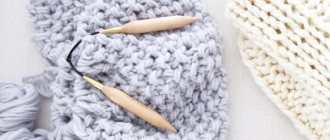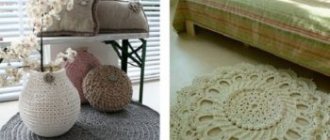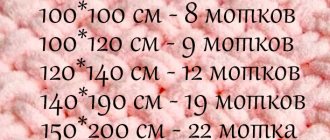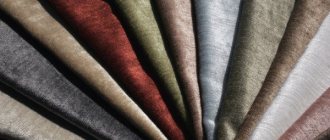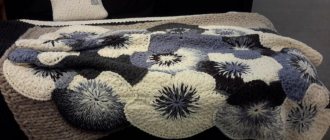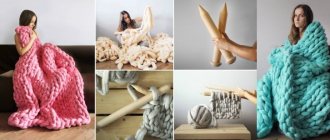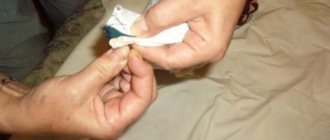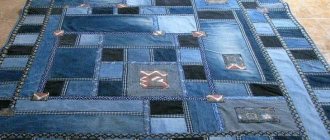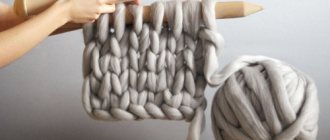12/27/2019 Category: Bedspreads
- 1 Features of work
- 2 Functionality of blankets
- 3 Cons
- 4 Types
- 5 Techniques and patterns
- 6 Materials
- 7 Colors
- 8 Dimensions
- 9 Styles
- 10 How to choose
- 11 How to care
- 12 Options in the interior
- 13 How to knit a blanket
- 14 Benefits of DIY
- 15 Required materials and tools
- 16 How long to knit by time
- 17 How much yarn is needed for a blanket
- 18 Conclusion
Interior knitwear is a broad topic for lovers of needlework, especially when it is a knitted blanket or bedspread. It’s easy to make a cozy cover for a chair with your own hands. You won't need a complicated pattern unless it's a mermaid tail blanket or other themed item for a child. The technique is selected according to the level of skill and the yarn available.
Features of work
Handmade knitted bedspreads are a luxury. Not every craftswoman will undertake to create a New Year's blanket with a jacquard pattern. The huge fabric takes a long time to move forward - loop by loop (knitting needles) or column by column (hook).
The lengthy process can take a long time; some masterpieces take years to knit. Something similar can be seen in museums. For example, a plaid with a small pattern knitted by serfs in the Turgenev estate (the village of Spasskoye-Lutovinovo, Oryol region), which took 2 years to knit.
There are techniques for speeding up the production of large knitted fabrics. For an ultra-fashionable blanket without knitting needles or a hook, they even developed mega-yarn of great thickness so that the work progresses faster. This knitted blanket can be completed in 1-2 days.
Note! The thicker the yarn and the larger the number of knitting needles or hook, the less time will be spent on the model you like.
Volumetric patterns will require a lot of yarn consumption. The consumption rate for a blanket “10 out of 10” is 1 large skein. Standard – 1.5-2 kg, sometimes less or more.
So what to knit from?
If you knit a blanket for a newborn in the warm season, choose cotton mixed threads.
Openwork cotton baby blanket for newborns
If you need a warm blanket, pay attention to wool blend threads with the addition of acrylic.
Children's warm blanket with merino wool braids
For those who knit a blanket for a crib or for playing on the floor, we recommend children's acrylic.
Children's blanket knitted with a three-dimensional pattern
Now, armed with our practical advice, feel free to take up knitting.
Easy loops for you.
Functionality of blankets
Large handmade panels are used in different ways. It’s nice to wrap yourself in them in the winter after work while watching TV, reading something or knitting while listening to quiet music.
When it's warm, a blanket made from a pleasant-to-touch yarn will serve as a substitute for a light blanket. Any variety will serve as a beautiful cover for a bed or chair.
You can choose a fun children's blanket made from soft knitted yarn. The windows where monkeys, bunnies or kittens have successfully “registered” will look funny. They are suitable for beginners because they are small in size. A knitted baby blanket for a newborn serves as a plush blanket in the stroller, but is then used to decorate the baby’s room.
Children's blanket "Bunny"
How to knit a beautiful, stylish and modern blanket with your own hands?
What yarn to knit a blanket from?
In order for the planned blanket to turn out exactly the way you want, it is important to choose the right yarn and buy it profitably for knitting the blanket.
Here are the main criteria for choosing yarn for such a large product: 1. Age . For children - only natural, non-fluffy threads. Because of its characteristics, the best yarn for a children's warm blanket is made from merino wool: it maintains heat balance well, is soft, does not irritate the delicate skin of even newborns, and does not cause allergies. It is better to knit a summer blanket from knitted yarn: cotton easily allows air to pass through, absorbs moisture well, is soft and pleasant to the touch, and easy to care for.
2. Skill level . Beginner knitters should choose mohair. Its fluffy thread allows you to slightly disguise the mistakes and unevenness that are inevitable at the initial stage. Large patterns will simplify the work, and a competent combination of colors will allow you to create a stylish modern blanket even with simple knitting in stripes or checks. Very beautiful products are also obtained by combining the front and back stitches in different directions. Craftswomen with extensive experience can easily cope with both relief patterns and complex braids.
3. Seasonality . For crocheting a blanket for the spring-autumn season, a mixture of angora yarn and acrylic is very convenient. When knitted in 2 threads, blankets from it are soft, airy, warming, with delicate patterns. But you definitely shouldn’t use such a thread for a baby blanket to avoid getting fluff into the baby’s nose and eyes.
4. Time spent on mating. Thinner yarn and more complex patterns mean you will spend a lot of time on needlework. Experienced needlewomen knit from yarn of the usual thickness on average for about 5 days. Knitting a blanket from super thick yarn can take no more than 2 hours.
5. Decorative . Have you chosen an interesting scheme with complex patterns? Choose thin yarn. Want to use simple knitting patterns? You need thick yarn. Experienced needlewomen recommend not to complicate the design of the blanket too much, so that, due to the numerous openwork, such a large canvas does not lose its even boundaries. It is especially important not to make baby blankets too lacy, so that the baby does not get entangled in them and become upset again.
6. Number of loops to start working with . When the yarn for the blanket is selected, you need to calculate the number of loops. This is easy to do by knitting a 20x20 swatch with the chosen pattern for the main fabric. Measure the finished sample in centimeters and determine how many loops you need to make for the size of blanket you need. Remember about the fact of shrinkage! It is better to always leave a small margin in anticipation of this phenomenon.
7. Knitting method . The simplest stitch is garter stitch. But because of it, the blanket will tuck at the edges, so to process them, use a different knitting method. Blankets are crocheted beautifully and quickly with Canadian rib: counting stitches is easy, mistakes are quickly noticed and corrected in a timely manner. Such blankets are elastic and wear-resistant.
How much yarn do you need for a blanket?
The amount of yarn is calculated based on the size you need. For a tiny baby blanket for a newborn in a crib and for a huge one for a double bed or sofa, and even from yarn of different thicknesses, you will obviously need different quantities. But in any case, bobbin yarn is usually used for blankets - this is both profitable and convenient; you don’t have to deal with numerous knots on such a large product.
The size of 0.8 x 1.0 m is enough to cover a newborn with a baby blanket and to wrap the baby. This blanket will require 700 g of yarn. You can calculate more accurately only when choosing a specific yarn - a consultant in the store will help you with this, just ask him.
A size of 0.7 x 0.7 m is enough if you only cover the baby, for example, in a stroller. Yarn for this size will require from 400 g.
The size of 1.5 x 2 m is optimal for a single bed. The average yarn consumption is 1.5-2 kg.
The size of 1.3 x 1.7 m is good for most chairs.
For a large blanket made of super thick yarn you need at least 3 kg.
!!! Always take a small amount of yarn! If a situation suddenly arises that you have miscalculated the amount of yarn, it may be difficult to purchase an additional skein or bobbin!
!!! The yarn consumption for braids and various kinds of relief patterns increases significantly!
How to knit a blanket from thick yarn by hand?
Will you be knitting a thick blanket? It will become not only a pleasant warm thing for cozy evenings, but also interior decor, and this imposes its own requirements on the selection of yarn.
In this case, a hyper-bulky hand knitting yarn of maximum thickness is usually chosen. It makes a huge hand knitted blanket without knitting needles in just a couple of hours!
It should be taken into account that when using such yarn, the pattern of the future knitted blanket will be as simple as possible - primitive satin stitch, alternating knit and purl knitting, light braids spaced apart in space or single dot patterns. Complex patterns in a small room will look awkward and heavy.
As practice shows, the most interesting look is the gentle transitions of one shade of yarn to another. But this requires breaking the threads, delays the knitting time, and makes it impossible for subsequent unraveling and new knitting.
Knitting a simple blanket: easy patterns for beginners
Children's knitted blanket with pattern
Very often, original delicate blankets, crocheted according to intricate patterns, become a heartfelt gift for the birth of a baby. Do you have a mother-to-be who would be delighted to receive such a gift? So let's knit a beautiful children's blanket with crochet or knitting according to the following patterns with a description:
Stylish interesting ideas and motifs for blankets
When you want to knit a blanket, you have to spend a lot of time looking for attractive, original and at the same time modern ideas for combining colors, shades, patterns, and shapes. Our needlewomen have already spent their time scrolling through magazines, social networks, and the Internet for various requests. All you have to do is look through their selected works below:
We knit blankets in squares
Squares are an ideal way to use up leftover yarn in different shades from knitting other projects. After all, you can not only make the squares themselves in different shades and colors and combine them in interesting ways, but also create multi-colored transitions inside the squares. Look at the blankets below made from leftover yarn with knitting needles - what a wide field for creativity! And how interesting they look in a modern interior!
Minuses
- Prolonged painstaking work can cool interest. Large knitted fabrics have a chance of becoming “lanky” or “undersized”, which craftswomen often complain about.
- Large yarn consumption is a significant expense. The best solution is a blanket made from leftover yarn of different colors, but they rarely have artistic value.
- Two or three kilograms of yarn (or more) is a beautiful, but heavy product. They don’t even take it off the double bed at night, rolling it into a roll. They are left at the feet or under pillows, which is not always convenient.
- Many varieties of yarn do not hold their shape well, especially a blanket knitted with a loose pattern.
Artificial yarn
Synthetic threads are used more often for knitting blankets. This is primarily due to their low cost (compared to natural materials). Products made from them do not require careful care, tolerate machine washing well and do not fade. Let's look at the main varieties of such yarn.
- Acrylic yarn. It is analogous to natural wool and has many thickness and color options. The only negative is that fabric made from such yarn does not allow air to pass through well; sleeping under a blanket can be uncomfortable. Otherwise, the finished product is flawless - it holds its shape well, is not afraid of machine washing and lasts a long time. The cost of thread is low, so even a large bedspread will be relatively cheap;
- Plush yarn. Made from viscose or acrylic. A distinctive feature is the fluffy structure with small, uniform fibers. A blanket made from this material looks like fur. Often, for ease of knitting, plush yarn is produced in the form of a thread with ready-made loops. To create a blanket, you do not need knitting needles; you just need to thread the loops according to a given pattern;
- Nylon yarn. In appearance and properties it resembles acrylic thread. In its pure form, it is not suitable for knitting a blanket, but it is often used as an additive to the main thread (for example, wool). This gives the finished canvas strength and durability.
In addition to natural and artificial, there are mixed varieties of yarn for knitting a blanket. Usually it is natural fiber with the addition of synthetics, in a percentage ratio of 70/30. This yarn is considered the best option for knitting a large blanket. Blended yarn is affordable in cost, it is easy and pleasant to knit, and the finished product is durable and of high quality.
Types
Depending on seasonality, knitted blankets and wicker bedspreads are classified:
- winter varieties (made from fluffy warm wool, goat down, cashmere, llama or alpaca);
- openwork knitted summer blankets (made of threads with a cooling effect - cotton, linen, viscose);
- all-season bedspreads (from mixed yarn, acrylic, any synthetics).
Interior designs such as blanket owls or “hearts” are not used for insulation - this is a design accent in the interior.
Another alternative is a wide, warm stole used as a cover for an armchair or sofa deck.
Techniques and patterns
The choice of pattern and execution technique largely depends on the skill of the needlewoman. The easiest way to knit a yellow blanket is with squares (6- or 8-gons) from leftover yarn, starting from a corner. The smallest balls will do.
The simplest thing is to knit individual colored or openwork stripes, which are then sewn together. For a blanket of 10 loops you need mega yarn.
Today there is a yarn for which you do not need to know one way or another of knitting. This is a DIY blanket without knitting needles. A soft cover for a chair - ready-made loops and “ears” are woven by hand according to the instructions for the skeins.
Blanket made from large knit mega yarn
What pattern do you need for a blanket?
The choice of pattern is influenced by the yarn:
- For straight threads, you can choose any pattern. If the product is for children, then the baby’s fingers will easily get caught in the openwork knitting.
- Therefore, large patterns are better; they are much easier to work with.
For beginner craftswomen
Any patterns will seem difficult for beginners; for them it is better to choose combinations with different colors of yarn. These can be large squares or stripes, which will decorate the product and be easy to make. You can choose 2 shades of thread or several, it’s up to the master’s taste.
Advice! You can alternate knit stitches with purl stitches; all you need to do is change the colored skeins of thread. So, without using patterns, it’s easy to achieve an excellent result!
The edges of the product can be decorated with fringe or crocheted.
Materials
To work, you need yarn in large quantities with a reserve. The surplus will be used to decorate sofa cushions. A large knitted panel is a great way to organize unwanted yarn that bites. There is a reason to try color variations that would be inappropriate in sweaters or blouses. For example, mustard with purple and lilac or white with green and black.
Needlewomen often unravel old sweaters and vests for reuse. For the same purpose, they buy things made from “grass”, bouclé or “puffy” in second-hand stores for dissolution - to reduce the price of the product.
After unraveling, you will end up with deformed yarn that requires straightening. The curl is steamed in skeins wound around the elbow.
Helpful advice! The unraveled yarn is not completely straightened after processing. In knitting projects this is more noticeable; the “curly” pattern is more suitable for a crochet hook. In pom-poms and fringe tassels, the defect is even more noticeable; all you need is new yarn.
Colors
As a rule, there is no disagreement with the choice of color. Whatever yarn is available in the house is what they work with. When knitted from leftovers. then what is important here is the combination of shades and their overall balance. It is better when dark shades predominate in winter products, light shades in summer capes.
Important! For a baby blanket, you should not use too bright colors, they will irritate the baby.
When you want something new and very beautiful for an interior product, it is better to take milk instead of white, it’s more practical. It is better to replace black with purple, chocolate or dark blue. unless it is a priority color in the interior.
Calm, non-spectral colors, all shades of chocolate, as well as gray, beige and caramel tones are considered universal.
Luxurious gray interior bedspread
Dimensions
It all depends on the purpose of the product and the density of the pattern. In the finished description of the model from fashion magazines, all parameters are indicated.
Small children's blanket - at least 50-75 cm.
Blanket for a chair - dimensions are adjusted according to the seat format, usually 60x120 cm.
Large bedspread - from 120x170 to 120x220 cm. Working on long winter evenings, without straining, you will not notice how gradually a large triangle will be formed from individual fragments from the corner, complemented by a rectangular panel.
Photo gallery of beautiful children's blankets made from various yarns for inspiration:
PreviousTextilesHow to starch bed linen
Next
Textiles Table of bed linen sizes
Styles
Blankets made from “grass” that imitate fur look original; they fit perfectly into the “winter” format of the interior under Scandinavian minimalism.
Everyone knows patchwork, an imitation of a patchwork quilt. An exquisite addition to a country house interior or a private house in the style of a Russian hut.
Beautiful handmade bedspreads for a bed in a bedroom in the spirit of Provence.
Intarsia with a 3D effect will decorate a modern loft, attic or large recreational guest area in a house without walls.
Neutral products with a simple pattern will decorate any home. Lots of warm blankets are an option for a home with many children.
How to choose
On social networks they often show handmade interior knitwear without patterns, and their eyes widen. There are simple ones in terms of skill and complex ones, real masterpieces. Lots of luxurious bedspreads for the double bed.
How to knit something original? There are 3 options:
- Completely repeat the product you like, repeating the pattern and color.
- Add some variety, according to the available supply of threads.
- Design your own masterpiece using a familiar technique, a beautiful prayer or a pattern of a pattern you like.
Important! Blankets with a circular frame (frame) look more attractive. Fringe, pompoms or handmade tassels will help add sophistication to the product.
Hand knitted fringe
Video tutorial on knitting a blanket with a pattern
We have already learned how to knit blankets of different types and complexity, but what the process of step-by-step execution looks like is a completely different question, the answer to which can be found in detailed videos with master classes on knitting a blanket. In this case, we are talking about a beautiful blanket with several patterns.
Video “how to knit a blanket with a pattern”
And this is what the process of knitting a simple blanket looks like from a master class for beginners:
Share with your friends!
Read us in the Zen channel
How to care
Handmade knitted fabrics are no different. Once finished, they do not need to be washed and steamed like sweaters and blouses.
Washing heavy knitted fabric is problematic due to the large volume of the product. The threads absorb a lot of water, and even after spinning in a centrifuge, the blanket will be heavy. Mega yarn for blankets does not require washing (dry dry cleaning).
Attention! A heavy bedspread should not be crushed too much with your hands, nor should the top be lifted or twisted by hand. It will stretch and lose its shape.
The product is soaked in warm water with liquid soap in the bath, wrung out several times, replacing washing. Then they drain the soapy dirty water without removing the blanket. After rinsing twice with clean water at the same temperature.
A hand-knitted blanket is wrung out in a centrifuge and dried on terry towels in an unfolded form - on the floor or table. Ironing and steaming are not necessary. If the yarn is fluffy, the front side can be lightly fluffed with a brush by quickly hitting a slightly damp surface.
Merino and wool are the best option for the cool season
Merino yarn is almost as popular as cotton for knitting children's blankets. Merino is cozy, soft, warm, and if it is also superwash, then practical. This blanket is especially good for cool evenings, the off-season and autumn.
The German brand Schacenmayr, in the same Bay Smiles series, has an excellent children's merino yarn, which is called Merino Wool. It is very light, soft and beautiful. In addition, it can be washed and dried in a machine. A blanket will require 15-20 skeins, which is not the most economical in terms of consumption.
I would recommend Rowan Pure Wool Superwash DK - this is not a children's series, the palette is also “marshmallow-free”, but you can choose beautiful shades for a baby. But the yarn is timeless, practical, airy and very pleasant. Pure wool, and tactilely - not a hint of prickliness. consumption - 8-10 skeins.
Merino Mix blend yarn from Schachenmayr is very good for a children's blanket. This is merino with polyamide, 50/50. The thread is soft, airy, quite warm and easy to care for. And the best part is that such a blanket is inexpensive. You will need 7-8 skeins.
I also recommend Sport yarn from Bergere de France. This is a soft, light and pleasant thread, easy to care for and very easy to work with. You can knit anything from it, including light and beautiful blankets that are quite warm and cozy. 10 skeins should be enough for a baby blanket.
This is not a blanket, but I couldn't help but share
Another good and inexpensive option - if the baby is not allergic to wool - is a blanket made from Baby Wool wool yarn. This is Russian brand yarn, 100% wool, very soft, very pleasant to the touch, without the slightest hint of prickliness. Well, the palette is a sight for sore eyes.
Options in the interior
Interior blankets are a unique accent in the design of different rooms:
- cozy living room;
- matrimonial bedroom;
- women's boudoir;
- guest room;
- children's "bedchamber".
Note! The huge advantage of hand-made products is that you can knit a whole set.
Under a knitted blanket from common yarn you can knit the following amazing beauty:
- rounded poufs;
- sofa cushions;
- chair covers;
- rugs under your feet.
Handmade interior knitwear has a unique charm. There are simple patterns, but they are difficult to copy, descriptions are needed. The beauty of many crochet motifs is difficult to replicate without a pattern - this is a great advantage of exclusive samples.
Handmade luxury
Schemes and descriptions of a blanket with knitting needles
We tried to choose the simplest and at the same time interesting patterns for crocheting a blanket.
Bright multi-colored plaid
Size 90x90. For it you need:
- 75 grams of yarn (blue, lilac, white, turquoise, red, light green, pink), 95 m in 50 grams;
- knitting needles number 5
Scheme
Simple black and white plaid
This product takes a long time to knit, because it is large - 130x160 cm. But it is very simple - with regular garter stitch. For knitting you need:
- 1400 g of black and white melange yarn (79 m in 50 g);
- knitting needles number 10.
Note! You need to knit with a thread in two folds.
Description of work:
Cast on 120 stitches and knit:
12 rows in garter stitch (knit and purl rows - knit stitches);
2 rows of stockinette stitch (knit rows - knit stitches, purl rows - purl stitches);
12 rows in garter stitch;
2 rows of purl stitch (knit rows - purl stitches, purl rows - knit stitches).
Continue this way until the product reaches the desired length, and then bind off the loops.
Relief blanket
This blanket combines raised and openwork patterns. Looks great!
Scheme
Soft blanket
A very simple blanket to make will be an excellent decoration for any living room.
Scheme
Openwork plaid knitted
A delicate cream blanket can give warmth and comfort to you and your loved ones.
Scheme
How to knit a blanket
When you want to learn how to knit, use products without a pattern - scarves, blankets, stoles. To begin with, it is important to decide on the method of execution. It is better to choose a pattern that is pleasant to work with. Some people only know how to knit or crochet, while others have access to complex combined techniques.
It is recommended to knit a sample to determine the number of loops (columns). The continuous fabric is knitted according to a pattern calculated by the number of repeats along the width of the product.
Helpful advice! A solid piece of fabric without a pattern is an easy job. For curious knitters, this is a good reason to master some new pattern in practice.
The easiest way to make models is from squares, sewn or knitted to adjacent elements. They are knitted from the corner fragment. Beginners should not start with a large product; it is better to take on a canvas for a child’s room with a simple pattern.
How to knit a blanket from motifs?
Motifs can be used to knit blankets not only with crochet, but also with knitting needles. But there are some secrets here:
- decide on the dimensions and knit a test square to make an accurate calculation;
- select the desired colors and pattern;
- draw a pattern of alternating motifs on graph paper or a regular sheet of squared notebook.
All this simplifies the work. Because usually, for a plaid of motifs, it is recommended to knit squares with a side of 15-20 cm. But this is not at all necessary, you can make completely different motifs, the main thing is that in the end they come together into a single fabric, as in tetras.
The motives can then be consolidated:
- with a regular seam used to sew sweaters,
- or using half-columns and a hook,
- or some elegant decorative stitching.
The benefits of making it yourself
Any handmade item is a useful break from physical and intellectual work. This is a kind of meditation for the brain. Long knitting with identical fragments or a pleasant pattern gives peace of mind.
The result is a masterpiece that relatives and friends do not have. This is a great opportunity to use up leftover yarn and put your creativity to use.
Exclusive handmade squares
Required materials and tools
Knitted items require high-quality yarn and suitable tools to realize the idea.
The set of tools depends on the method of work. From mega yarn you can knit a large panel using carved methods:
- on the hands (loops are formed manually, throwing them from hand to hand);
- on thick wooden knitting needles (can be found on websites or in specialized stores);
- on plastic tubes with a melted end.
If you knit from regular yarn, you will need knitting needles No. 2.5 No. 3 or No. 4. With thin threads, work with No. 2, No. 2.5 or No. 3.
Important! You should not knit too tightly - this will increase consumption. Very rare knitting looks loose, and in rare patterns this is attractive.
To make some patterns, use a ruler (a wide wooden plank), a special fork or a long hook for Tunisian crochet. It is recommended to choose a familiar way of working that has been practiced before.
How long to knit by time
An interesting technique for forming a pink blanket from yarn and fluffy pompoms. In this way, children's rugs and bedding for a computer chair are knitted. To do this, make a large mesh of yarn, filling the markings on a wooden frame with nails. The intersections are tied with balls from the remains of the bobbins. This can be done in 3 days - first the frame with the mesh, then the pompoms, another 1 day to make the model.
Note! This type of needlework has its own records and lanky ones. A small blanket on your arms is made from mega yarn in 2-3 hours. Painstaking work with crochet or knitting from thin thread is completed in 2-3 months.
Some ideas can be implemented in a week, others will take 4-3 months to complete on long winter evenings. To get “something”, you need to be patient and work, enjoying the process.
Synthetic materials
In some situations, polyacrylic and acrylic are quite justified. It is inexpensive, soft, hypoallergenic and practical. For example, the wonderful children's yarn Lenja Soft from Schachenmayr. 100% acrylic, but would you pick it up! She is so soft, so pleasant. Also a fluffy one. The blankets made from it are simply charming and cozy. You will need about 10 skeins. The same yarn can be used for decorative finishing of merino blankets.
Another very good and fairly economical option is Ideal yarn from the French brand Bergere de France. This is generally a very versatile and in all respects pleasant blended yarn. Can be washed and dried in a machine. Knitted on 4 mm needles, beautiful shades. 8-10 skeins are enough for a blanket.
If you want a completely budget option, I recommend Angel Baby from the Russian brand ShveyTorg. This is 100% polyamide, that is, a practical and durable option. This is a special, children's, hypoallergenic yarn. Very soft and very pleasant to the touch. For a small blanket, 8-9 skeins are enough.
How much yarn do you need for a blanket?
The consumption of raw materials depends on the format of the product and the properties of the yarn. If you can find mega-yarn for a trendy cape with several loops in width, it’s better to buy it without hesitation. The result will be an original and fashionable item.
You will need:
- minimum 2 kg – for a product 80x120 cm;
- 3 kg – 100x150 cm;
- about 4.5 kg – 130x170 cm;
- 6 kg will make a luxurious blanket 1.5 x 2 m.
Much depends on what product is taken as a basis. From the remnants of ordinary “winter” yarn you can knit:
- 1.2-2 kg – for a children’s plush blanket;
- 1.3-1.5 kg – chair cover;
- 2-2.3 kg – standard format (for a folding sofa);
- 2.5-3 kg – large bedspread for a double bed (possible ± in both directions).
Time will fly by, and the end result will be a delightful blanket for “stunning selfies on Insta.”
Comparison of the best yarns for knitting
To make it easier to compare all of the above yarns, we will use a summary table.
| Yarn name | price, rub. | Footage | Compound | Season | Peculiarities | Thickness | Hook/Knitting Size |
| Alize Puffy, Türkiye | from 115 | 9.2m/100g | 100% micropolyester | any | knitted with fingers | thick | – |
| Alize Lanagold, Türkiye | from 152 | 240m/100g | 51% acrylic, 49% wool | winter | suitable for beginners | average | 4-6 |
| YarnArt Jeans, Türkiye | from 76 | 160m/50g | 55% cotton, 45% polyacrylic | demi-season | ideal for beginners | average | 3,5/3,5 |
| Alize Angora gold Türkiye | from 121 | 550m/100g | 80% acrylic, 20% wool | demi-season, winter | Suitable for experienced knitters | thin | 2-4/3-6 |
| YarnArt Dolce, Türkiye | from 179 | 120m/100g | 100% micropolyester | any | hypo-allergenic | thick | 6,5/4,5 |
| Biskvit knitting yarn, Russia | from 300 | 330g/100m | 100% cotton | any | ideal for bags and home decoration | thick | 8-10 |
| YarnArt Flowers, Türkiye | from 540 | 250g/1000m | 55% cotton, 45% polyacrylic | summer | beautiful gradient | thin | 3/2,5 |
| Gazzal Baby Wool, Türkiye | from 92 | 175m/50g | 40% acrylic, 40% merino, 20% cashmere PA | winter | hypo-allergenic | thin | 3/3 |
| Himalaya Dolfin Baby, Türkiye | from 160 | 120m/100g | 100% Polyester | any | plush yarn | thick | 4,5/6,5 |
| Vita Coco Cotton, | from 67 | 240m/59g | 100% mercerized cotton | summer | natural cotton, ideal for summer | thin | 2/1,5-2 |
